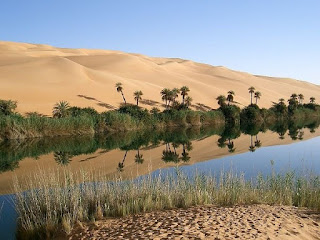The influence came form the more powerful with the rise of Islam. Islam spread rapidly through-out the Middle East, North East, & parts of Europe. Cities like, Cordoba of Spain, Cairo of Egypt, & Baghdad in Irag (of today) became the most important centers of the Islamic world.
Good things like, knowledge, ideas, technology & goods flowed through the Arab lands. Bringing the knoweldge of paper making to Europe form China, later it became one of the most influential religions in the world.
Thursday, March 31, 2011
Arabian Mountains.
The Largest mountain ranges are along the Western & Southern edges of the penninsula. Dividing the coastal plain from the desert.
In the winter the mountains may have a thin layer of frost. Ancient dry river beds cut down the sides of mountains & fill with water during rain storms.
People have lived on the Arabian mountains for thousands of years. Being so isolated, they came up with their own ways of life. Instead of years ago, mud houses, they live in dwellings. For farming they created step like terraces (flat areas). Terrace walls conserved water and kept it from running off into the feilds. Farmers also created dams & irrigation systems, storing extra rainwater in storage containers, leather bags & hollwed out trees. This is a picture of the Asir Mountains.
The Coastal Plains:
Dry river beds cut through the coastal plains & oftenly fill with water. These areas are suitable for farming. In the sixth century most of these people were larmers on the coastal plain. Growing, grians, fruits & vegeatbles.

Traders also existed on the coastal plain. Sending goods by caravan to towns like Makkah or seaports.
People on the coastal plain traded with merchants of places such as; India, East Africa, lands along the Red Sea & Persian Gulf.
Arabian Peninsulas:
Lying on the cross roads of Asia, Africa, & Europe. Great civilizations grew up in this divine area. Great deals of trade went through this area. Carried silk from China, along with jewels, cotton, & spices from India.

Dry river beds cut through the coastal plains & oftenly fill with water. These areas are suitable for farming. In the sixth century most of these people were larmers on the coastal plain. Growing, grians, fruits & vegeatbles.

Traders also existed on the coastal plain. Sending goods by caravan to towns like Makkah or seaports.
People on the coastal plain traded with merchants of places such as; India, East Africa, lands along the Red Sea & Persian Gulf.
Arabian Peninsulas:
Lying on the cross roads of Asia, Africa, & Europe. Great civilizations grew up in this divine area. Great deals of trade went through this area. Carried silk from China, along with jewels, cotton, & spices from India.

Sumerians built complex civilaizations along the valleys of the Tigris & Euphrates rivers in present day Iraq. In the west, Egyptions built their societies on the banks of the Nile. Later, Greeks, Romans, &Persian largly impacted the Middle East.
Oases...continued
Deserts are dotted with oases. Providing great shade and water for animals & people. Nomads for centuries traveled from oasis to oasis searching for water, and shade (vegetation). Palm trees commonly grew in oases. The palm leaves were the best shade givers.
Oases dwellers grew many fruit including, dates, peaches, & grains mostly to make some sorts of bread. Eventually, the date palm tree became very invaluable.
Oases dwellers grew many fruit including, dates, peaches, & grains mostly to make some sorts of bread. Eventually, the date palm tree became very invaluable.
The Oasis
Environment:
Oases occur in areas where water has been trapped underground. On fertile land plants will sprout up. Usually grass & shrubs. Oases can be a few acres to very large pieces of land.
Oases occur in areas where water has been trapped underground. On fertile land plants will sprout up. Usually grass & shrubs. Oases can be a few acres to very large pieces of land.
The Coastal Plain Environment & Adaptations
Environment:
This is a coastal plain in Arabia. Coastal PLains range between five & fourty miles each, ending in rocky cliffs. Rain falls pretty regularly. They usually have a few natural harbors.
Adaptations:
For centuries farming communities thrived in Southern Arabia. The people of Arabia built deep wells & dams & irrigation systems. Conserving rain water in canals. One dam lasted as long as 1,000 years, but sadly aroung 580 BC the walls broke through and water flowed out. The coastal plains are great for farming. Growing fruits, vegetables & grains. Also collecting fragrant tree sap, to make myrrh & frankincense.
This is a coastal plain in Arabia. Coastal PLains range between five & fourty miles each, ending in rocky cliffs. Rain falls pretty regularly. They usually have a few natural harbors.
Adaptations:
For centuries farming communities thrived in Southern Arabia. The people of Arabia built deep wells & dams & irrigation systems. Conserving rain water in canals. One dam lasted as long as 1,000 years, but sadly aroung 580 BC the walls broke through and water flowed out. The coastal plains are great for farming. Growing fruits, vegetables & grains. Also collecting fragrant tree sap, to make myrrh & frankincense.
Subscribe to:
Comments (Atom)












